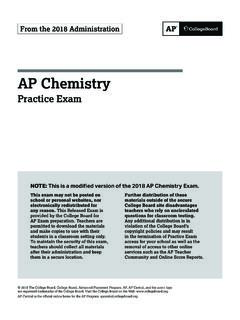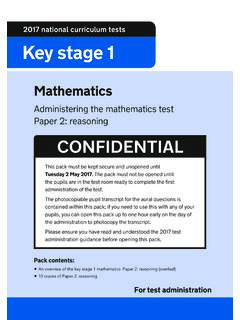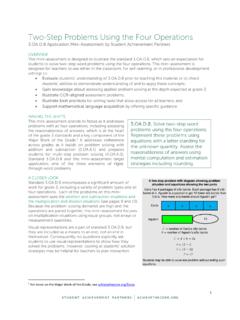Transcription of Aspen HYSYS Simulation of CO2 Removal by Amine …
1 Aspen HYSYS Simulation of CO2 Removal by Amine Absorption from a Gas Based Power Plant SIMS2007 Conference, G teborg, October 30-31st 2007. Lars Erik i Telemark University College, Norway Abstract vent followed by desorption. The principle of the Removal process is shown in figure 1. The simplest A simplified combined cycle gas power plant and a and most used Amine for CO2 Removal is MEA. MEA (monoethanol Amine ) based CO2 Removal (monoethanol Amine ). This Removal process has a process have been simulated with the process simu- high consumption of thermal energy, and one of the lation tool Aspen HYSYS . The thermodynamic prop- main aims of improvement is to minimize this en- erties are calculated with the Peng Robinson and ergy consumption. In the case of CO2 Removal from Amines Property Package models which are avail- a combined cycle gas power plant, it is natural to able in Aspen HYSYS .
2 The adiabatic efficiencies in cover the heat requirement for CO2 stripping with compressors, gas turbines and steam turbines have steam from the power plant. A possible steam outlet been fitted to achieve a total thermal efficiency of 58 from a typical combined cycle process is shown in % in the natural gas based power plant without CO2 figure 2. Removal . The efficiency is reduced to about 50 %. with CO2 Removal . The CO2 Removal in % and the energy consumption in the CO2 Removal plant are calculated as a function of Amine circulation rate, absorption column height, absorption temperature and steam temperature. With CO2 Removal of 85 %, heat consumption is calculated to MJ/kg CO2. removed, close to a literature value of MJ/kg CO2. Keywords: Aspen HYSYS , CO2 Removal , mono- ethanol Amine , absorption. 1.
3 Introduction Figure 2. Principle of combicycle power plant Because testing at large scale is so expensive, it is natural to use process Simulation to evaluate such Figure 1. Principle for CO2 Removal process based on processes. There are however few literature refer- absorption in Amine solution. ences on process Simulation of CO2 Removal from exhaust gases at atmospheric pressure. There are some journal articles [1-4], and 3 of them have used The possibility of removing CO2 from fossil fuel the process Simulation program Aspen Plus. As- based power plants has got increased interest due to penTech bought the program HYSYS from Hypro- environmental reasons. The most actual method for Tech in 2002, and in 2006 the program name was CO2 Removal is by absorption in an Amine based sol- changed to Aspen HYSYS .
4 The last reference [4]. uses a Fortran code to simulate the process. An im- 73. portant advantage with using a process Simulation CO2 + NRH2 RH2+NCOO- (1). program for such calculations, is that the available + - - +. RH2 NCOO + NRH2 RH2 NCOO NRH2 (2). models for thermodynamic properties can be used. Aspen Plus has an MEA property insert model [5] According to equation (1) and (2), two moles of which was used in all the references [1-3]. Aspen MEA are necessary to absorb one mole of CO2. HYSYS has an Amines Property Package [6]. A simple overall description of the combined ab- Within the Amines Property Package, one of the two sorption and reaction process is simply models, Kent Eisenberg or Li-Mather, can be se- lected. Even though Aspen HYSYS is probably the CO2 (gas) CO2 (absorbed) (3). most used process Simulation program in the world, The Removal of CO2 is not 100 %.
5 The % CO2 re- there has not been found any journal references on moval is limited both by low absorption and reaction CO2 Removal from atmospheric exhaust gas using rates and by the equilibrium conditions. this program. There is however much literature on CO2 Removal from natural gas at high pressure. If the kinetics in the reactions should be calculated, Other process Simulation programs containing Amine more details about the intermediate reactions in packages, are ProVision and ProMax. equation (1) and (2) should be included. This is done in the MEA property insert model in Aspen At Telemark University College, HYSYS has been Plus. used since 2000 to simulate CO2 Removal from gas based power plants. Most of this work has been The Simulation program Aspen HYSYS is mainly Bachelor and Master student projects with the author based on equilibrium calculations.
6 In that case, of this paper as supervisor. Major challenges in the equation (3) is sufficient to calculate the absorption Simulation of CO2 absorption and desorption proc- process. esses, are the description of thermodynamics and ab- sorption efficiency, convergence and total energy or cost optimization. Equilibrium models The purpose of this paper is to present and discuss The concentration of CO2 in the gas may be ex- the use of Aspen HYSYS for simulating CO2 re- pressed by the partial pressure pCO2 (eg. in bar) and moval from atmospheric exhaust by Amine absorp- the concentration in the liquid may be expressed by tion, and to simulate the total effect of efficiency re- CCO2 (eg. in mole/m3). duction in a combined cycle gas power plant. The equilibrium between the concentrations of CO2. in a gas and a liquid may be represented as a func- tion 2.
7 Available models pCO2 = f(CCO2) (4). Absorption and reaction mechanisms This expression might be a function of temperature, pressure and concentrations of the components in the The details of the mechanisms of CO2 absorption solution. There are many models available to de- into an Amine solution in an absorption column are scribe this function. quite complex. There are many references about the chemistry involved in the process, and many refer- In Aspen HYSYS , gas/liquid equilibrium for a com- ences and models comprising mass transfer mecha- ponent (i) is normally calculated using k-values de- nisms and chemical reaction kinetics. Reviews are fined by the equation written by Danckwerts and Sharma [7] and Versteeg Ki = yi/xi (5). [8]. where yi and xi are the mole fractions of (i) in the First, CO2 has to be transported from the gas to the gas and liquid phase.
8 For general purpose use, equa- liquid surface, and then it is absorbed in the liquid tion of state models like SRK (Soave Redlich solution. The gas liquid interface area a (in m2/m3) Kwong) and PR (Peng Robinson) are often used. and liquid holdup h (in m3/m3) are main parameters Aspen HYSYS recommends Peng Robinson [9]. in describing such mechanisms. Peng Robinson is regarded to be suitable to handle In the liquid, the CO2 may react chemically with systems containing hydrocarbons, water, air and other components. The following reactions are nor- combustion gases, the typical components in a natu- mally assumed to take place when CO2 reacts in a ral gas based power plant. primary Amine like MEA in an aqueous solution. In Traditional equation of state models are not regarded the case of MEA (NH2C2H2OH), R is C2H2OH.
9 To be suitable for non-ideal liquid systems. An Amine solution is an electrolytic system and also 74. comprises chemical reactions. This is not expected to be well described with traditional equations of state. Within the Amines Property Package in Aspen HY- SYS, one of the two models, Kent Eisenberg [10] or Li-Mather [11], can be selected. The models are quite complex, but in principle they are models to describe the equilibrium of the CO2 concentrations in the gas and the liquid (equation 4). Aspen Plus has an electrolytic package to calculate liquid systems containing ions. Different electrolyte equilibrium models can be used. Using an MEA. property insert model, equilibrium models can be combined with reaction kinetic models, including rate expressions of chemical reactions like equation (1) and (2).
10 Column models in Simulation programs Figure 3: Definition of Murphree efficiency A CO2 absorption column is a unit where gas flows up and liquid (eg. an Amine solution) flows down. CO2 is transfered from the gas phase to the liquid Most process Simulation programs have models for phase where it reacts with the Amine solution. The implementing Murphree efficiency in a column gas and liquid phases are made to get in contact by model. The Amines property package in Aspen the help of column plates or random or structured HYSYS has a special estimation method for predict- packing. ing this Murphree efficiency. This is based on the work of Tomkej [12]. This model is based on ex- The CO2 stripping column also has plates or pack- perience with CO2 Removal from high pressure natu- ing, and this column also has a reboiler at the bottom ral gas.







